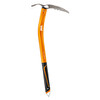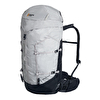François Legrand and his climbing
Interview with French rock climber, the unbeatable François Legrand.

 1 / 4
1 / 4
François Legrand
 Francesco Tremolada
Francesco Tremolada
At the very top of the international climbing competition scene since 1990, the Frenchman François Legrand has climbed many of the hardest routes not only in Europe, but also in the U.S.A, Brazil, Thailand and Japan.
Charismatic and at times introvert, he continues to be an inspiration for many youngsters who have adopted him as their role model. He enjoys travelling and meeting other climbers with whom he shares his passion for climbing, and he is also a tireless seeker of new crags, favouring those hidden and in fantastic natural surroundings.
For some time now I’ve tried to catch his thoughts on pen and paper, those ideas he’s shared with us in the most bizarre moments and places. For although he likes to explain things and examine a subject in-depth, it’s hard to find the “right” moment to sit down and discuss things. Finally we’ve managed to do just that.
MONKEYS
We’re in the sauna (!) in Milan’s Golden Gym, everything’s boiling hot… even the headphones and the small microphone which I place strategically on my knee. I wrap the tape recorder into a towel, worried that it may be damaged by the heat. All’s set, let’s begin.
At Phra Nang, where the rock formations have created beautiful overhanging routes with fantastic, athletic moves, you brought my attention to the monkeys nearby and said “let’s learn from them…”
Yes, I remember. You know, I like watching all animals, but monkeys in particular, because for us climbers they are truly impressive. They climb easily and pendulum a lot. I’ve observed them in zoos and outdoors, when I was lucky enough to catch sight of them, and I’ve analysed there movements. They are capable of making use of a specific type of energy, kinetic energy, and this really serves them well. We too need to make use of these pendulums on really overhanging routes, just like they do, making the most of the dynamic movement for the next move. Like this they only have to add a small bit of energy to progress – if they were to try the same move statically they’d never reach the next branches, sometimes as far as two meters apart.
This is what I try to apply to my climbing: to climb fluidly, making use of the energy from the preceding move! I really like this sensation and sometimes I manage to do it, but never as good as monkeys. If I were as good as them I’d really improve on these types of routes. Thinking about it though, I do have one advantage over them: I enjoy repeating a move even 100 times, while they wouldn’t understand why!
It would be nice to be able to imitate them naturally, just like children, who see things and then repeat them without thinking. But it’s not that easy, so we have to train specifically for this.
Since you need a great deal of finger strength to turn well and be able move dynamically, it’s worth learning in simple environment. To understand this concept you have to try it on easier routes suited to your level, with strong locks from one hold to the next, trying to work open-armed and catching the next hold. That’s why it’s better to try and learn on good holds on an overhanging route, and definitely not on a slab! And on an easier route, so that you can repeat the move without having to lock off violently.
What is rhythm?
It’s important to be able to change rhythm. You don’t have to start and finish like a rocket. I go quickly when I need to and slow down when I feel it’s worth it, because were I to carry on quickly I’d make a mistake or miss a rest. So I start fairly quickly in the beginning since I don’t need to rest and want to be fairly efficient. Then I see whether I need to rest and if there’s the chance of doing so I change rhythm, to calm my heart beat down and to be ready to accelerate once more. Otherwise you arrive at a section where you need to be quick and you can’t because you’re not ready, physically and mentally.
It’s worth making the effort and resting a second just before starting a difficult section, even if it’s only one move or the moves beforehand were difficult. Like this you can pull through the harder move with all your energy reserves and then continue at a normal speed.
You’ve talked about dynamic moves and rhythm, how can you best make use of a rest?
If you’re really tired, if the rest isn’t very good, then begin by rapidly changing hands on the hold, and then slowing down. When I rest however I never stay on a hold for too long as it’s not good. To recover well you have to change hands fairly frequently, you never stay on a hold for more than about 10 seconds, even if it’s good, because the muscle contracts and that arm doesn’t recover well. So in the beginning I stay on a hold for about 3-5 seconds, then in the end 5-10 seconds. When you’re ready to set off again you speed up once more, i.e. you don’t rest for 10 seconds on one hand and then 10 on the other, because your arm will be tired after a 10 second rest. So speed up to about 3-4 seconds. But when I climb I’m not there counting the seconds – it’s just to give you an idea!
Charismatic and at times introvert, he continues to be an inspiration for many youngsters who have adopted him as their role model. He enjoys travelling and meeting other climbers with whom he shares his passion for climbing, and he is also a tireless seeker of new crags, favouring those hidden and in fantastic natural surroundings.
For some time now I’ve tried to catch his thoughts on pen and paper, those ideas he’s shared with us in the most bizarre moments and places. For although he likes to explain things and examine a subject in-depth, it’s hard to find the “right” moment to sit down and discuss things. Finally we’ve managed to do just that.
MONKEYS
We’re in the sauna (!) in Milan’s Golden Gym, everything’s boiling hot… even the headphones and the small microphone which I place strategically on my knee. I wrap the tape recorder into a towel, worried that it may be damaged by the heat. All’s set, let’s begin.
At Phra Nang, where the rock formations have created beautiful overhanging routes with fantastic, athletic moves, you brought my attention to the monkeys nearby and said “let’s learn from them…”
Yes, I remember. You know, I like watching all animals, but monkeys in particular, because for us climbers they are truly impressive. They climb easily and pendulum a lot. I’ve observed them in zoos and outdoors, when I was lucky enough to catch sight of them, and I’ve analysed there movements. They are capable of making use of a specific type of energy, kinetic energy, and this really serves them well. We too need to make use of these pendulums on really overhanging routes, just like they do, making the most of the dynamic movement for the next move. Like this they only have to add a small bit of energy to progress – if they were to try the same move statically they’d never reach the next branches, sometimes as far as two meters apart.
This is what I try to apply to my climbing: to climb fluidly, making use of the energy from the preceding move! I really like this sensation and sometimes I manage to do it, but never as good as monkeys. If I were as good as them I’d really improve on these types of routes. Thinking about it though, I do have one advantage over them: I enjoy repeating a move even 100 times, while they wouldn’t understand why!
It would be nice to be able to imitate them naturally, just like children, who see things and then repeat them without thinking. But it’s not that easy, so we have to train specifically for this.
Since you need a great deal of finger strength to turn well and be able move dynamically, it’s worth learning in simple environment. To understand this concept you have to try it on easier routes suited to your level, with strong locks from one hold to the next, trying to work open-armed and catching the next hold. That’s why it’s better to try and learn on good holds on an overhanging route, and definitely not on a slab! And on an easier route, so that you can repeat the move without having to lock off violently.
What is rhythm?
It’s important to be able to change rhythm. You don’t have to start and finish like a rocket. I go quickly when I need to and slow down when I feel it’s worth it, because were I to carry on quickly I’d make a mistake or miss a rest. So I start fairly quickly in the beginning since I don’t need to rest and want to be fairly efficient. Then I see whether I need to rest and if there’s the chance of doing so I change rhythm, to calm my heart beat down and to be ready to accelerate once more. Otherwise you arrive at a section where you need to be quick and you can’t because you’re not ready, physically and mentally.
It’s worth making the effort and resting a second just before starting a difficult section, even if it’s only one move or the moves beforehand were difficult. Like this you can pull through the harder move with all your energy reserves and then continue at a normal speed.
You’ve talked about dynamic moves and rhythm, how can you best make use of a rest?
If you’re really tired, if the rest isn’t very good, then begin by rapidly changing hands on the hold, and then slowing down. When I rest however I never stay on a hold for too long as it’s not good. To recover well you have to change hands fairly frequently, you never stay on a hold for more than about 10 seconds, even if it’s good, because the muscle contracts and that arm doesn’t recover well. So in the beginning I stay on a hold for about 3-5 seconds, then in the end 5-10 seconds. When you’re ready to set off again you speed up once more, i.e. you don’t rest for 10 seconds on one hand and then 10 on the other, because your arm will be tired after a 10 second rest. So speed up to about 3-4 seconds. But when I climb I’m not there counting the seconds – it’s just to give you an idea!
Note:
Latest news
Expo / News
Expo / Products
Merino Wool Ski Mountaineering Sock.
Technical footwear for high altitude mountaineering and ice climbing.
The Guida HDry gloves are the evolution of the Guida model, enhanced with HDry technology, making them ideal for all weather conditions.
Technical performance ice axes for classic mountaineering Petzl Summit Evo.
A lightweight mountaineering backpack for demanding conditions and terrain.
Lightweight helmet for climbing, mountaineering and ski mountaineering.



 Copia link
Copia link
























